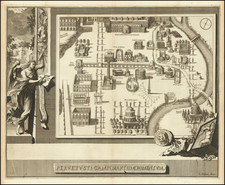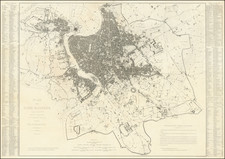A wonderfully detailed bird's-eye view of Rome, this antiquarian engraving by Georg Braun and Frans Hogenberg hails from Cologne, circa 1572, presenting an intricate depiction of the city's monumental structures and topography during the mid-sixteenth century.
Presented in this engraving is Rome in its grandeur, fortified within the Aurelian Walls, a stretch of 19 kilometers in length and six meters in height dating back to the 3rd century. The noteworthy ruins of Ancient Rome are vividly rendered within these walls, providing a glimpse into the city's rich history. Among the many landmarks are the Coliseum, the Arch of Constantine, the Forum Romanum, and the Baths of Caracalla, each possessing stories that date back centuries, echoing the grandeur of the Roman Empire and its architectural prowess.
Central to the engraving is the Pantheon, a remarkably preserved architectural marvel from around 120 AD. The structure, consecrated to the Virgin and all the Christian martyrs by Pope Boniface VI in 609, evolved into Santa Maria Rotunda, further marking Rome's transformation under Christian dominance. This harmonious fusion of the city's Pagan past and Christian present is exemplified by the inclusion of both Santa Maria in Aracoeli, crowning the Capitoline Hill, and Trajan's Column to its left.
Across the Tiber, the engraving illuminates the Vatican area, dominated by the imposing Castel Sant'Angelo, originally built as Hadrian's mausoleum. The Old St Peter's Basilica, which underwent modifications since 1506, graces the scene, its monumental successor and the layout of St Peter's Square still under construction until the 17th century. The foreground on the left showcases the Papal Palace, with the obelisk—originally from the Circus of Caligula and Nero, marking the site of St Peter's martyrdom—strikingly positioned upfront. As such, this artifact serves as a testimony to Rome's layered history, preserving the grandeur of the past while capturing the changes yet to come.
Georg Braun (1541-1622) was born and died in Cologne. His primary vocation was as Catholic cleric; he spent thirty-seven years as canon and dean at the church St. Maria ad Gradus, in Cologne. Braun was the chief editor of the Civitates orbis terrarum, the greatest book of town views ever published. His job entailed hiring artists, acquiring source material for the maps and views, and writing the text. In this role, he was assisted by Abraham Ortelius. Braun lived into his 80s, and he was the only member of the original team to witness the publication of the sixth volume in 1617.
Frans Hogenberg (ca. 1540-ca. 1590) was a Flemish and German engraver and mapmaker who also painted. He was born in Mechelen, south of Antwerp, the son of wood engraver and etcher Nicolas Hogenberg. Together with his father, brother (Remigius), uncle, and cousins, Frans was one member of a prominent artistic family in the Netherlands.
During the 1550s, Frans worked in Antwerp with the famous mapmaker Abraham Ortelius. There, he engraved the maps for Ortelius’ groundbreaking first atlas, published in Antwerp in 1570, along with Johannes van Deotecum and Ambrosius and Ferdinand Arsenius. It is suspected he engraved the title page as well. Later, Ortelius supported Hogenberg with information for a different project, the Civitates orbis terrarium (edited by Georg Braun, engraved by Hogenberg, published in six volumes, Cologne, 1572-1617). Hogenberg engraved the majority of the work’s 546 prospects and views.
It is possible that Frans spent some time in England while fleeing from religious persecution, but he was living and working in Cologne by 1580. That is the city where he died around 1590. In addition to his maps, he is known for his historical allegories and portraits. His brother, Remigius, also went on to some fame as an engraver, and he died around the same time as his brother.










![[ Ancient Rome ] Urbis Romae Situs Cum IIS Quae Adhuc Conspiciuntur Veter Monumet Relquiis Pyrrho Ligiorio Neap Invent. Romae M. D. LXX](https://storage.googleapis.com/raremaps/img/small/96880.jpg)
![[Ancient Rome] Antiquae urbis perfecta et nova delineatio](https://storage.googleapis.com/raremaps/img/small/75180.jpg)
![[Rome / Controlling The Tiber River] Parer di Gio Paolo Maggio Archit Sopra l'inondation di Roma](https://storage.googleapis.com/raremaps/img/small/85891.jpg)

![[Rome] Rom. Rioni, Regionem od. Abtheilungen Rom's](https://storage.googleapis.com/raremaps/img/small/91898.jpg)